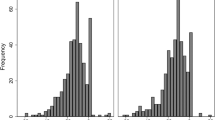Abstract
Statistics Sweden has interviewed representative samples of the population annually since 1980. This study looks at ages 65–84 (n ≈ 3,000 per year) and presents prevalence rates for functional ability (walking and running ability, vision and hearing, and disability) for different age groups and for men and women. Prevalence rates of functional problems increase with age, for all indicators and for men and women. With the exception of hearing, women have poorer function than men. Different function indicators showed different trends over time. For example, vision (reading text) improved over the studied time period, while hearing (a conversation between two or more people) showed a clear worsening over the time period. Seen over the entire time period 1980–2005, mobility items (running, walking) and disability indicators showed improvement. However, figures suggested that most of this improvement occurred during the 1980s and early 1990s. Regression analyses of the estimated trends up until 1996 show for the most part significant improvement, but this positive development seems to cease after 1996 and in some cases there seems to be a significant upswing in problems. On other hand, for hearing, the negative trend of increased problems seems to have been broken after 1996. Results emphasize the necessity to follow population trends over long periods of time with multiple waves and multiple indicators.






Similar content being viewed by others
Notes
N varies between survey waves and age/sex groups. For the smallest group, oldest men, n varies between 129 and 355 for different waves. For women aged 70–74, n varies from 342 to 438.
References
Ahacic K, Parker MG (2003) Mobility limitations 1974–1991: period changes explaining improvement in the population. Soc Sci Med 57:2411–2422
Batljan I (2007) Demographics and future needs for public long term care and services among the elderly in Sweden. Stockholm University, Stockholm
Commission E (2006) The impact of ageing on public expenditure: projections for the EU25 Member States on pensions, health care, long-term care, education and unemployment transfers (2004–2050) (No. 1/2006). Directorate-General for Economic and Financial Affairs, Brussels
Fritzell J, Lennartsson C, Lundberg O (2007) Health and inequalities in Sweden: long and short-term perspectives. In: Fritzell J, Lundberg O (eds) Health Inequalities and welfare resources, continuity and change in Sweden. The Policy Press, Bristol, pp 19–41
Johansson S-E, Batljan I, Qvist J, Sundquist J (2006) Förändringar i de äldres hälsotillstånd från 1988/89 till 2002/03–bortfallets betydelse (Changes in health status of elderly people from 1988/89 to 2002/03–the importance of non-response). In: Vogel J, Häll L (eds) Äldres levnadsförhållanden, Arbete, ekonomi, hälsa och sociala nätverk 1980–2003 (living conditions of the elderly, work, economy, health and social networks 1980–2003). Statistics Sweden, Stockholm, pp 355–409
Kuh D, Ben-Shlomo Y, Lynch J, Hallqvist J, Power C (2005) Life course epidemiology. J Epidemiol Community Health 57:778–783
Lafortune G, Balestat G, Members DSEG (2007) Trends in severe disability among elderly people: Assessing the evidence in 12 OECD countries and the future implications (No. 26). Organisation for Economic Co-operation and Development, Paris
Lagergren M (2004) Utvecklingen av de äldres hälsa och levnadslängd (Development of health and life expectancy among elderly people). Stiftelsen Stockholms läns Äldrecentrum, Stockholm
Larsson K, Thorslund M (2006) Old people’s health in Sweden—the National Public Health Report 2005. Scand J Public Health Suppl 67(34):185–198
Malmberg B, Sundström G (2004) Äldres levnadsförhållanden 1988–2002. Hälsa, funktionsförmåga och vård- och omsorgsmönster (Living conditions among elderly people 1988–2002. Health, functioning and care utilization patterns). Socialstyrelsen (National Board of Health and Welfare), Stockholm
Manton KG (1990) Mortality and morbidity. In: Binstock RH, George LK (eds) Handbook of aging and the social sciences. Academic Press, San Diego, pp 64–90
OECD (2007) Population pyramids in 2000 and 2050. Retrieved September 2007, from http://www.oecd.org/dataoecd/52/31/38123085.xls
Parker MG (2000) Sweden and the United States: is the challenge of an aging society leading to a convergence of policy? J Aging Soc Policy 12(1):73–90
Parker MG, Thorslund M (2007) Health trends in the elderly population: Getting better and getting worse. Gerontologist 47(2):150–158
Parker MG, Ahacic K, Thorslund M (2005) Health changes among Swedish oldest old: prevalence rates from 1992 and 2002 show increasing health problems. J Gerontol A Biol Sci Med Sci 60(10):1351–1355
Persson G, Bostrom G, Allebeck P, Andersson L, Berg S, Johansson L et al (2001) Elderly people’s health–65 and after. Health in Sweden: The National Public Health Report 2001, Chapter 5. Scand J Public Health Suppl 58:117–131
Robine JM, Michel JP (2004) Looking forward to a general theory on population aging. J Gerontol A Biol Sci Med Sci 59(6):M590–M597
Rosen M, Haglund B (2005) From healthy survivors to sick survivors–implications for the twenty-first century. Scand J Public Health 33(2):151–155
UN (2007) World population prospects: the 2006 revision population database. Retrieved September 2007, from http://esa.un.org/unpp
Wolf DA, Mendes de Leon CF, Glass TA (2007) Trends in rates of onset of and recovery from disability at older ages: 1982–1994. J Gerontol Soc Sci 62(1):S3–S10
Acknowledgments
We are grateful for the financial support from the Swedish Council for Working Life and Social Research, grants 2003-0539 and 2002-0919.
Author information
Authors and Affiliations
Corresponding author
Rights and permissions
About this article
Cite this article
Parker, M.G., Schön, P., Lagergren, M. et al. Functional ability in the elderly Swedish population from 1980 to 2005. Eur J Ageing 5, 299–309 (2008). https://doi.org/10.1007/s10433-008-0096-2
Published:
Issue Date:
DOI: https://doi.org/10.1007/s10433-008-0096-2




